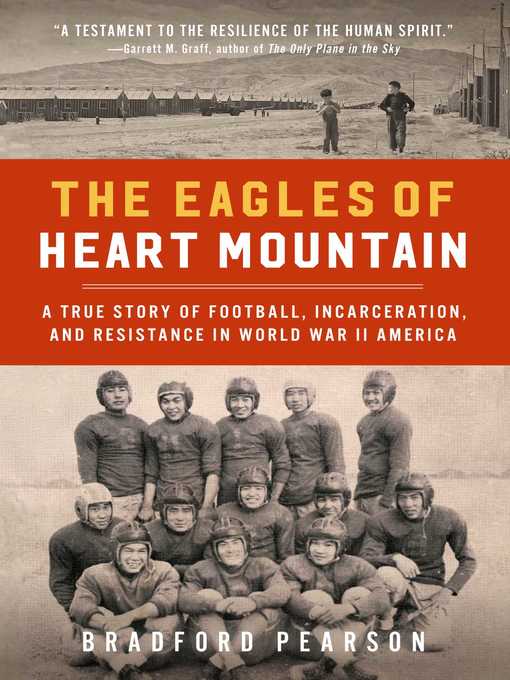
The Eagles of Heart Mountain
A True Story of Football, Incarceration, and Resistance in World War II America
کتاب های مرتبط
- اطلاعات
- نقد و بررسی
- دیدگاه کاربران
نقد و بررسی

November 2, 2020
Journalist Pearson debuts with a novelistic account of sports glory at the Heart Mountain Relocation Center in Wyoming. Pearson sketches the history of anti-Asian immigration policies leading up to President Roosevelt’s 1942 executive order authorizing the detainment of Japanese Americans living on the West Coast, and paints a harrowing picture of life at Heart Mountain, where detainees endured extreme temperatures, hunger, and substandard medical care. Yet more than a dozen social clubs sprouted within the camp’s first year, and Heart Mountain High School started a football team coached by a former star athlete from the University of Wyoming. Most of the boys who joined were “scrawny” and had never played the sport before, Pearson notes, yet the Eagles lost only one game in two seasons and might have won a conference championship if players from a local rival hadn’t refused to play them. Pearson intertwines play-by-play game recaps with updates on the war’s progress, biographical sketches, and rundowns on the legal battles over internment and military draft resistance by detainees. Frequent tangents interrupt the narrative momentum, yet Pearson succeeds in unearthing a feel-good story from a dark chapter in U.S. history. The result is a worthy portrait of triumph in the face of tragedy. Agent: David Patterson, Stuart Krichevsky Literary

December 15, 2020
Located in north-central Wyoming, Heart Mountain was one of 10 inland "relocation camps" where West Coast-based Japanese Americans were interned following the Japanese bombing of Pearl Harbor on December 7, 1941. And, yes, while the football teams of high-school-age incarcerees from Heart Mountain would dominate their local public-school rivals--and the author profiles the games and the stars of those teams--their story pales beside that of how they and their fellow Japanese Americans would end up there, which Pearson meticulously details, from their pre-Pearl Harbor lives to the evolution of U.S. policy that created the camps, uprooted these wholly Americanized families, and shamelessly drafted young men from the camps to fight the war--and to the resistance to the draft that many of them mounted (arguing that they should be granted their civil rights first), for which they were jailed. It might not have the sports appeal of most "local team makes good" stories, but Pearson's account will fill gaps in readers' understanding of this unsavory chapter in American history.
COPYRIGHT(2020) Booklist, ALL RIGHTS RESERVED.

Starred review from January 1, 2021
In this debut, Pearson explores the history of the Heart Mountain Relocation Center in Wyoming, which was one of ten concentration camps used for the internment of Japanese Americans during World War II. Pearson tells the moving story of the Heart Mountain Eagles, a high school football team organized at the camp. In telling the story of the team and the internment camp itself, Pearson describes ongoing fear, racism, and discrimination, especially as surrounding rural, white communities in Wyoming refused to play against the team. The author also recounts in detail the decades-long enmity toward Japanese Americans, and how they responded to their imprisonment and treatment. The football team, which lost only one game over the 1943 and 1944 seasons, remains a backdrop to the larger story of racism and resilience--and how sports offered a way for boys to channel their frustration, anger, and disappointment. Pearson's descriptions of players and their families gives life to Japanese communities that developed in Wyoming as well as Washington State, the home of other camps, in the later part of the 20th century. VERDICT This well-written and researched book will strongly appeal to those interested in U.S. history and civil rights.--Mark Jones, Mercantile Lib., Cincinnati
Copyright 2021 Library Journal, LLC Used with permission.

January 1, 2021
A fresh look at the mass removal and incarceration of Japanese Americans during World War II. In his first book, journalist Pearson immediately rejects the bloodless language that calls the imprisonment of American citizens "internment" and "relocation." It was incarceration--"an imperfect solution, implying that those imprisoned had committed crimes"--in places that should properly be called concentration camps. Those jailed were ordinary citizens, many of whose ancestors were recruited as agricultural labor and whose young were so thoroughly Americanized that they played league sports on multiracial teams. At the Bay Area's Mountain View Union High School, writes the author, "in class pictures, Yoshinagas and Yamijis and Okamotos stood next to Gruenebaums and Popoviches and Mendozas." Some players, such as Babe Nomura of star-studded Hollywood High School, would surely have gone on to college scholarships and even professional careers had they not been swept up, following Franklin Roosevelt's Executive Order 9066, in the mass imprisonment of Japanese Americans in such inhospitable places as Wyoming's Heart Mountain. Japanese athletes regrouped there, playing sports among themselves and then, thanks to some surprisingly sympathetic locals, against other schools on the statewide athletic circuit. Admittedly irregular--some of the players were well beyond school age, Pearson writes--the young men did their best at basketball, baseball, and football. When the military came calling, looking for recruits even among the imprisoned, many refused, going on to twofold imprisonment as draft resisters. Pearson's narrative goes on a touch too long, but his play-by-plays read compellingly like contemporary radio scripts: "As the third quarter kicked off, Kaza Marumoto found a pinch of that luck, landing on top of a Bulldog fumble on the Eagle 36. Mas Yoshiyama dropped Don Ash for an 11-yard gain, Bill ran for a short gain of 3, and Mas galloped for another 9." But sports take second place to social justice, and this book serves that cause well. A deep-reaching chronicle of a shameful episode in American history.
COPYRIGHT(2021) Kirkus Reviews, ALL RIGHTS RESERVED.

























دیدگاه کاربران